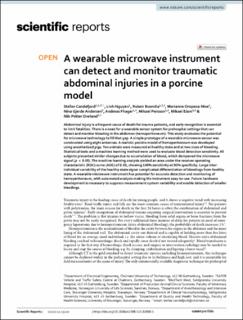| dc.contributor.author | Candefjord, Stefan | |
| dc.contributor.author | Nguyen, Linh | |
| dc.contributor.author | Buendia, Ruben | |
| dc.contributor.author | Oropeza-Moe, Marianne | |
| dc.contributor.author | Andersen, Nina Gjerde | |
| dc.contributor.author | Fhager, Andreas | |
| dc.contributor.author | Persson, Mikael | |
| dc.contributor.author | Elam, Mikael | |
| dc.contributor.author | Oveland, Nils Petter | |
| dc.date.accessioned | 2022-04-01T08:13:53Z | |
| dc.date.available | 2022-04-01T08:13:53Z | |
| dc.date.created | 2022-01-04T18:21:00Z | |
| dc.date.issued | 2021-12 | |
| dc.identifier.citation | Candefjord, S., Nguyen, L., Buendia, R., Oropeza-Moe, M., Andersen, N. G., Fhager, A., Persson, M., Elam, M., Oveland, N.P. (2021) A wearable microwave instrument can detect and monitor traumatic abdominal injuries in a porcine model. Scientific Reports, 11 (1), 23220 (2021) . | en_US |
| dc.identifier.issn | 2045-2322 | |
| dc.identifier.uri | https://hdl.handle.net/11250/2989077 | |
| dc.description.abstract | Abdominal injury is a frequent cause of death for trauma patients, and early recognition is essential to limit fatalities. There is a need for a wearable sensor system for prehospital settings that can detect and monitor bleeding in the abdomen (hemoperitoneum). This study evaluates the potential for microwave technology to fill that gap. A simple prototype of a wearable microwave sensor was constructed using eight antennas. A realistic porcine model of hemoperitoneum was developed using anesthetized pigs. Ten animals were measured at healthy state and at two sizes of bleeding. Statistical tests and a machine learning method were used to evaluate blood detection sensitivity. All subjects presented similar changes due to accumulation of blood, which dampened the microwave signal (p<0.05). The machine learning analysis yielded an area under the receiver operating characteristic (ROC) curve (AUC) of 0.93, showing 100% sensitivity at 90% specificity. Large inter-individual variability of the healthy state signal complicated differentiation of bleedings from healthy state. A wearable microwave instrument has potential for accurate detection and monitoring of hemoperitoneum, with automated analysis making the instrument easy-to-use. Future hardware development is necessary to suppress measurement system variability and enable detection of smaller bleedings. | en_US |
| dc.language.iso | eng | en_US |
| dc.publisher | Springer Nature Switzerland AG | en_US |
| dc.rights | Navngivelse 4.0 Internasjonal | * |
| dc.rights.uri | http://creativecommons.org/licenses/by/4.0/deed.no | * |
| dc.subject | traumatologi | en_US |
| dc.subject | akuttmedisin | en_US |
| dc.subject | mikrobølger | en_US |
| dc.title | A wearable microwave instrument can detect and monitor traumatic abdominal injuries in a porcine model | en_US |
| dc.type | Peer reviewed | en_US |
| dc.type | Journal article | en_US |
| dc.description.version | publishedVersion | en_US |
| dc.rights.holder | © The Author(s) 2021 | en_US |
| dc.subject.nsi | VDP::Medisinske Fag: 700::Klinisk medisinske fag: 750::Traumatologi: 783 | en_US |
| dc.source.pagenumber | 10 | en_US |
| dc.source.volume | 11 | en_US |
| dc.source.journal | Scientific Reports | en_US |
| dc.source.issue | 1 | en_US |
| dc.identifier.doi | 10.1038/s41598-021-02008-5 | |
| dc.identifier.cristin | 1974706 | |
| dc.source.articlenumber | 23220 (2021) | en_US |
| cristin.ispublished | true | |
| cristin.fulltext | original | |
| cristin.qualitycode | 1 | |

